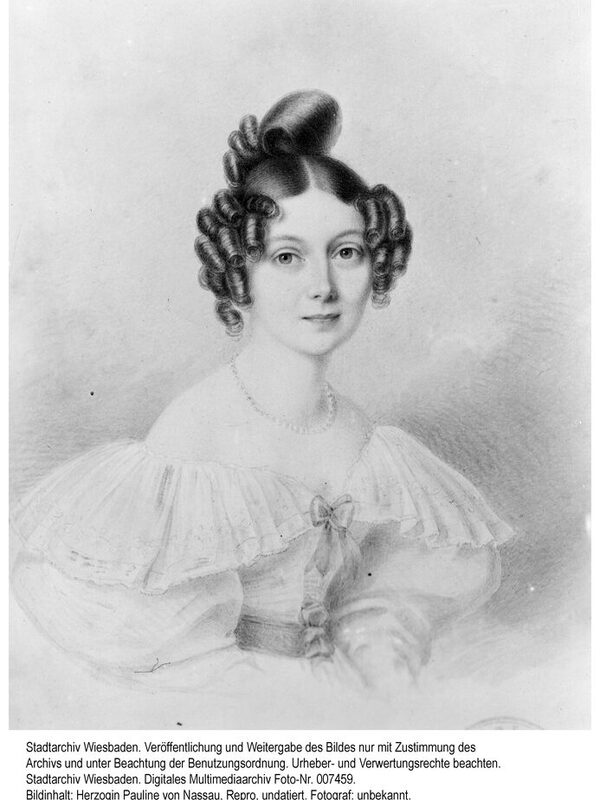Pauline Friederike Marie Duchess of Nassau, née Princess of Württemberg
Pauline Friederike Marie Duchess of Nassau, née Princess of Württemberg
born: 25.02.1810 in Stuttgart
died: 07.07.1856 in Wiesbaden
Pauline was the daughter of Princess Katharine Charlotte of Saxe-Altenburg and Prince Paul Karl Friedrich August of Württemberg. After her marriage to the widowed Duke Wilhelm zu Nassau on 23.04.1829, Pauline became sovereign princess. Before her arrival in Wiesbaden, the Duke had Biebrich Palace remodeled according to her wishes. Pauline had three children of her own and four stepchildren. When Duke Wilhelm died in 1839, he was succeeded by the 22-year-old unmarried Prince Adolph. Pauline continued to fulfill the duties of a sovereign princess and moved with her three young children into the former Heersche Haus, Rheinstraße 21. Her palace, the Paulinenschlösschen, was completed in 1845. A glamorous meeting place for high society developed here in the following years. The very close, friendly relationship between her and Duke Adolph was repeatedly perceived as disturbing in court circles. Among other things, she arranged the Duke's marriage to her niece, the Russian Princess Elisabeth Duchess of Nassau.
In 1848, the year of the revolution, Duke Adolph was in Berlin. In Wiesbaden, his absence stirred up rumors that he wanted to secretly send in military troops from outside. On March 4, 1848, Pauline and her children were in the City Palace, which was surrounded by 30,000 to 40,000 people. In order to avert major riots, Minister of State Emil August von Dungern recognized the demands of the Nassau population. Pauline and her son Prince Nikolaus Wilhelm joined in and made themselves available as guarantors. On the same day, Pauline had 2,000 fl. distributed to poor Nassau residents.
Throughout her life, she worked to improve social conditions, set up pensions for individuals and provided temporary financial support for families in need. She wished to remain unrecognized as a donor. She also gave work to unskilled and poor women, supported the Wiesbaden Women's Association's work and soup institute, the Jungfrauenverein's children's home and other socially active women's associations. She promoted the establishment of the Protestant rescue home for neglected children, informed herself about the new female profession of deaconess and, in contact with Katharina Fliedner shortly before her death, laid the foundations for the Paulinen Foundation named after her.
In accordance with her wish to be buried with her people, she was buried in today's Old Cemetery and not in the family vault of the Nassau princes. The street running parallel to Wilhelmstraße and Warme Damm was named Paulinenstraße after her death.
Literature
Blisch, Bernd: In the footsteps of Pauline von Nassau 1810-1856. Projektbüro Stadtmuseum. Cultural Office of the State Capital of Wiesbaden (ed.), Wiesbaden 2010.
Klein, Beatrixe: Seven Women - Seven Lives - Seven Stories, Wiesbaden 2005.
